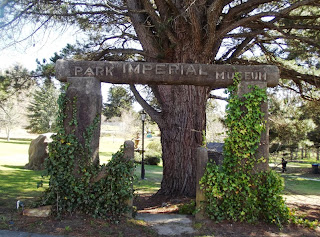MT VICTORIA PARK
BLUE MOUNTAINS NEW SOUTH WALES AUSTRALIA
Mt
Victoria is on the western edge of the Blue Mountains. It
came into existence mainly because of the coming of the railway in 1868, when
it became the terminus while the Great
Zig Zag was being constructed near Lithgow. This allowed the railway to
descend from the mountains to the more fertile regions beyond. The development
of Jenolan Caves as a tourist resort
brought crowds to the town as it became the base for those coming from Sydney
by train before transferring to road transport for the rest of the journey.
Right from the construction of the first road across the Blue Mountains in 1815
until now, most road traffic has left the mountains at Mt Victoria.
Despite all of this development, the town’s
population has not exceeded 1,000 and today it is a quiet mountain community
which gives the impression that it plans to stay that way.
Mt
Victoria Park is one of the most accessible spots
along the Great Western Highway for travellers to stop for a break and they
share it with the locals who clearly have a great deal of affection for the
place.

Two of its entrances have signs over them; that
from the Highway calls the place “Memorial
Park” while the Station St entrance rather grandly states “Imperial Park Museum”. This reflects
the fact that the two sections of the park had different origins. The First
World War memorial is a prominent feature of one, the original community owned
part, while the other was formerly the property of the Imperial Hotel (across
the road). It contains a number of bizarre structures which look like they
might have once have held exhibits of some sort, perhaps animal dioramas,
though I haven’t been able to confirm this. See the photos at the end of this blog. The board appeared in the park early in 2016.
The two were merged as “Mt Victoria
Park” when the Blue Mountains City Council bought the lower section from the
Hotel owners in 1979.

The stimulus for the purchase of the land now
forming the core of the park seems to have been the centenary of the crossing
of the Blue Mountains in 1913. While nearby Mt York was the focal point for the
unveiling of memorials (just as it has been in 2013 for the bicentenary), a
site was needed which was more suitable for festivities, which was more
accessible and could accommodate a crowd. You can read about all this in the
newspapers of the day. The photograph (source unknown) show the crowds making
their way to the park for the celebrations in May 1913.
The park became the venue for large picnic groups
soon after this, since it is handy to the railway station. Railway picnics
brought thousands and you could say “a good time was had by all”.
The construction of the War Memorial must have been a great event too, and the newspaper
reports reveal the tremendous emotional energy behind the occasion. It seems
strange to us that it should have been unveiled 5 months before the war
concluded. Reading between the lines, it seems that feelings were running high
in the community, as they were in many other small places where some men were
perceived as not “doing their duty”.
Some
recommended reading (source www.trove.nla.gov.au): The 1913 Centenary celebrations (Clarence and Richmond Examiner
(Grafton, NSW: 1889 - 1915), Thursday 29 May 1913, page 5);
The 1914 Railways Picnic (Nepean Times
(Penrith, NSW): 1882 - 1962), Saturday 12 September 1914, page 6);
The March of the “Cooees” (The Sydney
Morning Herald (NSW: 1842 - 1954), Friday 5 November 1915, page 8);
The opening of the War Memorial (The
Blue Mountain Echo (NSW: 1909 - 1928), Friday 7 June 1918, page 3).
View my Blue
Mountains videos here . I have three other playlists - gem hunting/mining, Glen Innes and New Zealand. The video about Mt
Victoria Park is here.
https://johnsbluemountainsblog.blogspot.com/2013/12/links-to-all-blog-entries-and-relevant.html All Blue Mountains blogs and videos
All New England and other Geology blogs and videos
Limestone Caves of NSW
Song Studies. Bible studies based on hymns and songs
Shoalhaven District Geology.







No comments:
Post a Comment